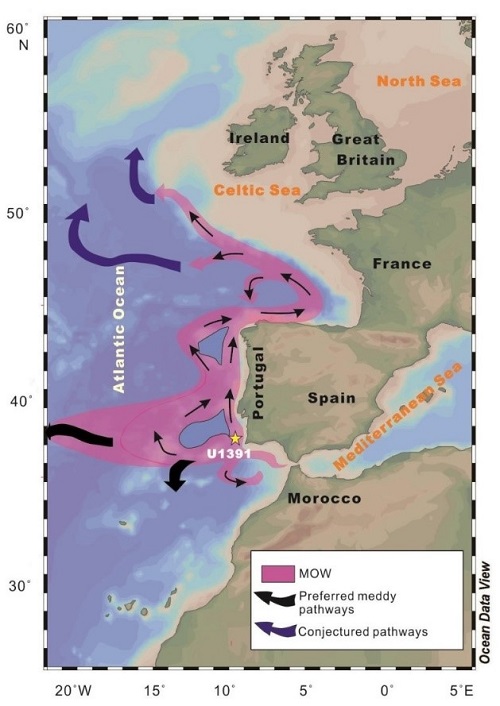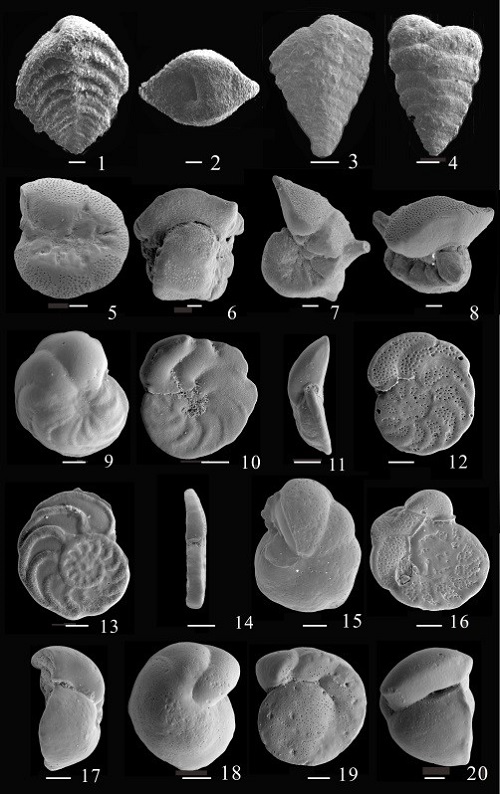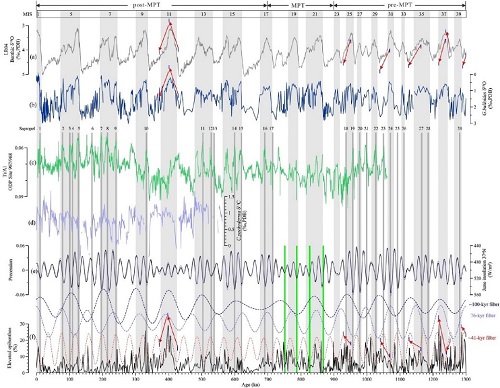The opening of Drake and Tasmania passages, the closures of the Central American isthmus and Indonesia sea way, and shutdown and reopening of the Gibraltar Straight played important role on the global ocean circulation and further influence the climate system and environment. After the Strait of Gibraltar re-opened at 5.33 million years ago, warm high-salinity Mediterranean outflow water (MOW) showered into the Gulf of Cadiz, north Atlantic, penetrating north along the Portuguese slope, even to the Norwegian- Greenland Sea region, which enhances the North Atlantic deep-water density and helps drive Atlantic Meridional Overturning Circulation (AMOC).
Foraminiferal fauna contains the rich information of the surrounding water, and responses sensitively to the environmental changes. The benthic foraminifera has the priority on the bottom water reconstruction. In collaboration with scientists form Portugal and Korea, Dr. GUO Qimei of Professor LI BaohuaI’s research group at Nanjing Institute of Geology and Palaeontology, Chinese Academy of Sciences(NIGPAS) performed the paleoceanographic analyses on Integrated Ocean Drilling Program (IODP) Site U1391 off the Portuguese margin based on benthic foraminifera and stable Oxygen/ Carbon isotopes of their tests. The above result was recently published in Quaternary Science Reviews.
The study reports the faunal composition and variation of benthic foraminifera during the last 1.3 Ma. Based on the high-resolution δ18O stratigraphy, “Elevated Epibenthos” group and Key species Planulina ariminensis contents of benthic foraminifera, the MOW dynamics across the middle Pleistocene transition (MPT) was reconstructed.
The data suggests that the MOW intensity has typical glacial-interglacial cycles, an active MOW current during the interglacial periods and a sluggish MOW current during the glacial periods. The strength of MOW was enhanced during MISs 1, 9-11, 19-21, and 37-39, reaching the lately peak at MIS 11, when the sea level was considered to rise up to ~20 m above the present high-stand.
The variation in the abundance of the “elevated epibenthos” group was dominated by ~41-kyr cycle prior to the MPT and by the ~100-kyr cycle after the MPT, which suggested there was an MPT-related shift in the MOW dynamics. The MOW variability of the last 1.3 Ma is the combination of the precession forcing and the obliquity forcing that work together. The precession forcing played an important role in the MOW dynamics of the entire time series, which explains the ~20-kyr high frequency oscillations in the “elevated epibenthos” record. The bottom water was well ventilated by MOW during the interglacial periods and by GNAIW during the glacial periods, and poorly ventilated during the glacial terminations.
The study also delineates the partial evolution of Mediterranean outflow water after the reopening of the Gibraltar Straight.
This work was supported by the Chinese Academy of Sciences (CAS) Strategic Priority Project, National Natural Science Foundation of China, the State Key Laboratory of Palaeobiology and Stratigraphy, and the Ministry of Ocean and Fisheries Korea (International Ocean Discovery Program) and IODP-China.
Reference: Guo, Qimei*, Li, Baohua*, Voelker, Antje, Kim, Jin-Kyoung, 2020. Mediterranean Outflow Water dynamics across the middle Pleistocene transition based on a 1.3 million-year benthic foraminiferal record off the Portuguese margin. Quaternary Science Reviews, 247: 106567. https://doi.org/10.1016/j.quascirev.2020.106567.
Guo, Qimei, Li, Baohua*, Kim, Jin-Kyoung, IODP Expedition 339 Scientists, 2017. Benthic foraminiferal assemblages and bottom water evolution off the Portuguese margin since the Middle Pleistocene. Global and Planetary Change, 150: 94-108. http://dx.doi.org/10.1016/j.gloplacha.2016.11.004.
Contact:
LIU Yun, Propagandist
Email: yunliu@nigpas.ac.cn
Nanjing Institute of Geology and Palaeontology, Chinese Academy of Sciences
Nanjing, Jiangsu 210008, China

General circulation pattern of the present Mediterranean Outflow Water (MOW) pathway in the eastern North Atlantic

Scanning electron microscope pictures of the elevated epi-benthic foraminifera from Site U1391

Variation of the “Elevated Epibenthos” at Site U1391 during the last 1.3 Ma, its comparison with global oxygen stable isotope curve (LR04), local insolation and other paleoceanographic index
Download:
